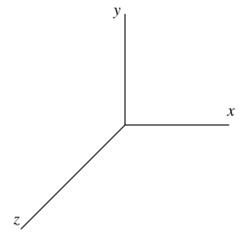Tropical projective space
In tropical geometry, a tropical projective space is the tropical analog of the classic projective space.
Definition
Given a module M over the tropical semiring T, its projectivization is the usual projective space of a module: the quotient space of the module (omitting the additive identity 0) under scalar multiplication, omitting multiplication by the scalar additive identity 0:[lower-alpha 1]
- [math]\displaystyle{ \mathbf{T}(M) := (M \setminus \mathbf{0})/(\mathbf{T} \setminus 0). }[/math]
In the tropical setting, tropical multiplication is classical addition, with unit real number 0 (not 1); tropical addition is minimum or maximum (depending on convention), with unit extended real number ∞ (not 0),[lower-alpha 2] so it is clearer to write this using the extended real numbers, rather than the abstract algebraic units:
- [math]\displaystyle{ \mathbf{T}(M) := (M \setminus \boldsymbol{\infty})/(\mathbf{T} \setminus \infty). }[/math]
Just as in the classical case, the standard n-dimensional tropical projective space is defined as the quotient of the standard (n+1)-dimensional coordinate space by scalar multiplication, with all operations defined coordinate-wise:[1]
- [math]\displaystyle{ \mathbf{TP}^n := (\mathbf{T}^{n+1} \setminus \boldsymbol{\infty})/(\mathbf{T} \setminus \infty). }[/math]
Tropical multiplication corresponds to classical addition, so tropical scalar multiplication by c corresponds to adding c to all coordinates. Thus two elements of [math]\displaystyle{ \mathbf T^{n+1} \setminus \boldsymbol{\infty} }[/math] are identified if their coordinates differ by the same additive amount c:
- [math]\displaystyle{ (x_0, \dots, x_n) \sim (y_0, \dots, y_n) \iff (x_0 + c, \dots, x_n + c) = (y_0, \dots, y_n). }[/math]
Notes
References
- ↑ Mikhalkin 2006, p. 6, example 3.10.
- Richter-Gebert, Jürgen; Sturmfels, Bernd; Theobald, Thorsten (2003). "First steps in tropical geometry". arXiv:math/0306366.
- Mikhalkin, Grigory (2006). "Tropical Geometry and its applications". arXiv:math/0601041.
 |


